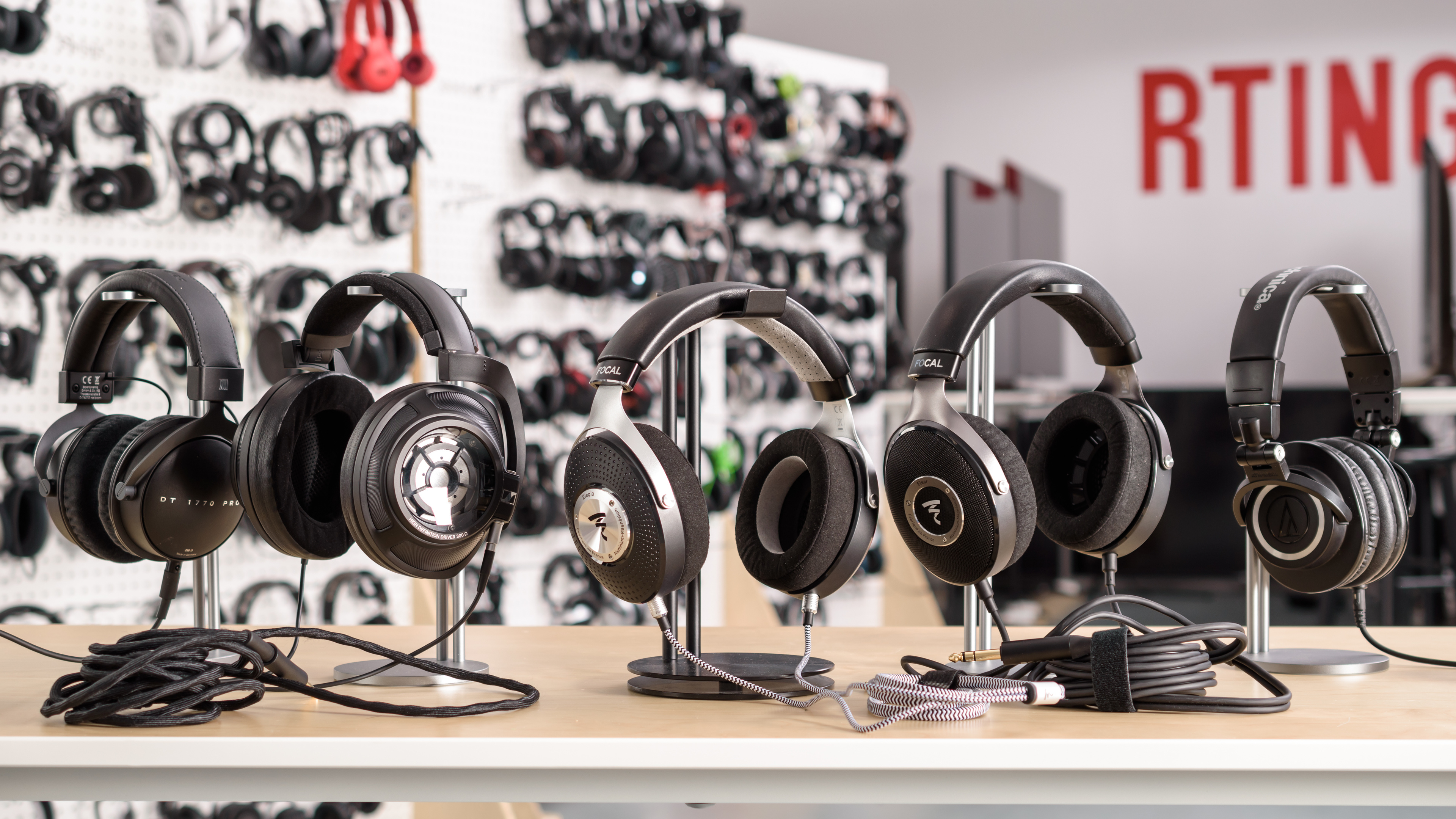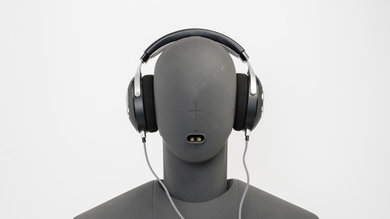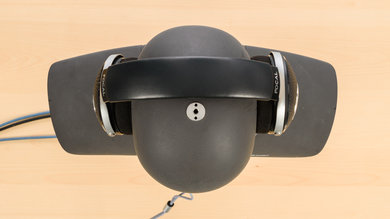The Focal Elegia are above-average critical listening headphones. They're the closed-back variant of the similarly designed Focal Elear. These premium headphones are very comfortable for long listening sessions and have a great build quality thanks to a metal frame and a detachable cable. They're a bit more versatile thanks to their closed-back design and shorter cable, which allows you to use them outside as well. Unfortunately, they won't be the best to use outdoors since they have a bulky design, their isolation performance is average-at-best, and they don't have an in-line remote with a microphone for calls. Nevertheless, these are headphones that should please most users who can afford them.
Our Verdict
The Focal Elegia are mediocre for mixed usage. They're designed for critical listeners who want to enjoy their good audio reproduction anywhere. They're the closed-back variant of the Elear, so they might be more versatile, but they're still not portable and stable for sports. They do, however, isolate more noise and could be a better choice for commuting or at the office, but won't as good as noise cancelling headphones or other closed-back over-ears we've tested. Unfortunately, their short cable won’t be ideal for watching TV, and they don't have a microphone for gaming.
- Solid and durable build quality.
- Good audio reproduction.
- Comfortable design.
- Bulky design.
- Bass delivery varies across users. Sensitive to glasses.
The Focal Elegia are above-average for neutral listening. They have an extended and powerful bass, a flat and even mid-range, and a decent treble. However, they have a slightly forward sounding mid-range. Overall, they're versatile for a variety of music genres and will please most users. They're also well-padded and comfortable for long listening sessions, and their great build quality will last you years.
The Focal Elegia are sub-par for commuting and traveling. They isolate more noise than the open-back Focal Elear and are very comfortable headphones to wear during long flights. They're also more travel-friendly thanks to a shorter cable, a good solid case, and a more lightweight design, but they still won’t be ideal for this use because of their bulky size and mediocre isolation performance. If you don’t mind the over-ear design for your commutes, these are decent, but won’t be as great as noise cancelling headphones.
The Focal Elegia are poor for sports. These over-ears are very bulky and not stable enough for physical activity. They'll wiggle around and fall off easily as soon as you start running or working out. They also have a thick cable that will be in your way. Heat will get trapped under the closed-back ear cups and make you sweat more than usual.
The Focal Elegia are mediocre for office. While they are comfortable for long hours and they have decent sound quality, they don’t isolate much noise and leak a bit so might not be ideal for a crowded office. If you’re working at a quiet office without too much ambient noise or chatter, they can be a good option for listening to music at moderate volumes.
The Focal Elegia are sub-par for gaming. Even if they have a decent sound quality and are very comfortable, they don’t have a microphone for online gaming. However, if you’re gaming alone in a quiet room and have a stand-alone microphone, or don’t need a microphone, these could be great headphones to game with thanks to their wired connection, great comfort, and good sound.
Changelog
- Updated Feb 09, 2023: We've added a comparison between these headphones and the Focal Bathys Wireless in Microphone Style.
- Updated Nov 21, 2019: Converted to Test Bench 1.3.1.
- Updated Nov 21, 2019: Converted to Test Bench 1.3.
- Updated Dec 21, 2018: Review published.
Check Price
Popular Headphones Comparisons

The Focal Elegia are good and versatile critical listening headphones. They have good audio reproduction, excellent build quality, and are very comfortable for long listening sessions. They're the closed-back variant of the Focal Elear, making them more versatile thanks to better isolation and a shorter cable to use outside without a problem. Unfortunately, they have bass delivery inconsistencies and they are very bulky headphones. They're also quite expensive and some headphones below might be better choices for their great price-to-performance ratio. See our recommendations for the best critical listening headphones, the best DJ headphones, and the best headphones for studio use.
The Focal Bathys Wireless are a more well-rounded pair of headphones than the Focal Elegia. If you're looking for more casual use headphones, you'll want to consider the Bathys. They're wireless headphones with USB-DAC mode, which converts a digital audio signal into an analog signal and reduces artifacts in your audio. They also have a companion app so you can customize their sound to your liking and noise cancelling to help block background noise around you. That said, the Elegia are wired headphones that are more comfortable and better built.
The Focal Celestee are the next generation of closed-back headphones in Focal's line-up, and they replace the discontinued Focal Elegia. Both headphones offer very similar overall performances and share the same comfortable and high-end design. However, the Celestee have a better passive soundstage performance while the Elegia can reproduce more low-bass.
The Focal Elegia and Focal Elear are two similarly-designed headphones that have the same great comfort and build quality. However, the Elear are open-back headphones, while the Elegia are the closed-back variant. Both have good audio reproduction, but the open design of the Elear will give you a more speaker-like experience. On the other hand, the closed design of the Elegia will isolate more and leak less, making them more versatile for outside use cases.
The Focal Stellia and the Focal Elegia are very similar closed-back critical listening headphones. They’re both very well-built, comfortable headphones. The Elegia have a more understated design whereas the Stellia have a retro look that stands out more. Some people may find the leather ear cups of the Stellia more pleasing on the skin and they also come with an XLR cable, which is a nice touch. They sound fairly similar overall, but the Stellia’s bass is a bit punchier, and their treble is slightly less underemphasized. Overall, it comes down to personal preference and taste; however, the Elegia provide better value for most. That said, if you’re looking for a more premium listening experience, the Stellia may be worth the investment.
Test Results
The Focal Elegia are great-looking headphones and are fairly similar to their open-back variant, the Focal Elear, with slight differences. They don’t have a grill on the ear cups and have more pronounced silver accents. Also, their shorter cable is black and white, while the other is all black. They stand out a bit more but still have a more neutral look. For headphones that stand out more, take a look at the Focal Stellia.
These headphones are very comfortable. They are well padded and feel similar to the Focal Elear. The ear padding feels a bit different, and the headphones don’t sit on the head quite the same way. However, the cups are still very large and deep, which will fit most ears without touching the drivers. They're decently tight on the head but don’t apply too much pressure, so you can wear them for hours without feeling fatigued. They're also a bit more lightweight than the Elear.
These headphones don't have an in-line remote with controls.
The Focal Elegia aren’t the most breathable headphones, especially since they're closed-back over-ears. Over-ears usually trap heat under the ear cups, and they don’t have a grill on the cups to help with airflow like the Focal Elear. They won’t be ideal for sports as you'll sweat more than usual with these headphones on. It should be noted that they had a somewhat awkward fit on our testing equipment, so we had to find a way to make them tighter. These results may be warmer than what you'd experience on a normal head with a normal fit.
Like most over-ears, the Focal Elegia have a bulky design and aren't very portable. They don't fold into a more compact format, and the cups don’t swivel to make the headphones lay flat. However, they do come with a nice solid case to protect them while you’re on the move, but it does add a bit of bulk.
They come with a big and hard case that will protect the headphones against scratches, water exposure, and impacts. The interior is molded to fit the headphones better and technically fits the Focal Elear as well.
The Focal Elegia are very well-built headphones that have a solid, high-end design. They're made the same way that the Focal Elear and Focal Celestee are. The whole build is almost all made out of metal, making them very solid. They also have a detachable cable, which is convenient and easily replaceable if broken, which makes them more durable. Overall, they have few moving parts and are built like premium headphones that should last you a while.
These headphones aren't very stable and won’t be an ideal choice for sports. They have a decently tight fit on the head, but as soon as you start running or exercising with them, they wiggle around and could easily fall off your head. However, this shouldn’t be an issue during casual listening sessions.
The frequency response consistency is decent. Their delivery in the bass range is quite consistent and within 3dB across most people. However, it's possible that wearing glasses could break the seal between the headphones and your ears and cause up to 6dB of drop in the bass range, which will be noticeable. On the other hand, they have a fairly consistent treble delivery under 10kHz across multiple re-seats, which is good.
The bass is excellent. The LFE (low-frequency extension) is at 10Hz, and low-bass is within 1dB of our neutral target. This means that the Focal Elegia have deep and extended bass with just the right amount of thump and rumble, making them suitable for bass-heavy genres like EDM, hip-hop, and film scores. Mid-bass and high-bass, responsible for the body of bass guitars, punch of the kick drums, and warmth of the vocals, are also quite flat and within 1dB of our target.
The Focal Elegia's mid-range is good. The overall response is even and flat throughout the range. This suggests a clear and well-balanced reproduction of vocals and lead instruments. However, the entire range is overemphasized by about 3dB, nudging the vocals and lead instruments to the front of the mix.
The Focal Elegia have decent treble performance. The overall response is relatively well-balanced but slightly uneven. The dips around 3kHz to 6kHz will have a small negative effect on the brightness and detail of the vocals and instruments. However, not everyone will have the same listening experience.
The imaging performance is great. Weighted group delay is at 0.19, which is excellent. The GD graph also shows that the entire group delay response is below the audibility threshold. This ensures a tight bass and a transparent treble reproduction. Also, the L/R drivers of our test unit were well-matched in frequency, amplitude, and phase. This is important for the proper placement and localization of objects (voices, instruments, video game effects) in the stereo field. However, these results are only valid for our test unit, and yours may perform differently.
The soundstage is poor. The PRTF graph shows a limited amount of pinna interaction and activation, and there's no 10kHz notch present, either. Since creating a speaker-like soundstage is dependent on an accurate and adequate pinna interaction, the Focal Elegia soundstage will be perceived as relatively small and located inside the listener's head, as opposed to in-front, and will feel less open than the open-back Focal Elear.
They have mediocre isolation. These headphones don't have active noise cancellation and therefore don't isolate in the bass range. Meaning they will let in the rumble of bus and airplane engines. In the mid-range, important for blocking out speech, they achieve isolation of 13dB, which is above-average. In the treble range, occupied by sharp sounds such as S and Ts, they achieve isolation of 27 dB, which is also above-average.
The leakage performance is below-average. A significant portion of their leakage is spread between 400Hz and 2.5kHz, which is a relatively broad range and concentrated in the mid-range. Therefore, their leakage will sound fuller than that of in-ears and earbuds, but not as loud and full as open-back headphones. However, the overall level of leakage isn't too loud. At 100dB SPL, the average leakage at a 1-foot distance was 43dB and peaked at 59dB, which is about the average office noise floor.
These headphones are designed for critical listening and don't have a microphone for calls. If you're looking for audiophile-centric headphones with a mic, you'll want to check out the Focal Bathys Wireless instead.
They don’t have a microphone, therefore there's no recording quality data.
They don’t have a microphone, therefore there's no noise handling data.
These are passive headphones that don't require a battery.
There isn't a companion app that could offer customization options for the Focal Elegia.
They aren't Bluetooth compatible headphones.
They don't have a dock. If you need headphones with a dock, consider the SteelSeries Arctis 7 Wireless 2017.














